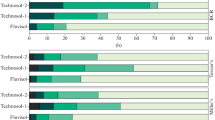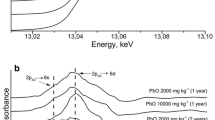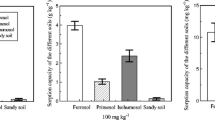Abstract
The application of the synchrotron technique of the third generation in soil science has permitted researchers to perform a quantitative mineralogical microanalysis in undisturbed samples and to reveal the relationship between the microelements and the solid phase of soils. Three principal methods are used in this technique: microfluorescence (μXRF), microdiffraction (μXRD), and the expanded analysis of the fine structure of the adsorption spectra. By the data of EXAFS spectroscopy, secondary arsenic was found to occur in three forms in soils, i.e., As adsorbed on iron hydroxides, scorodite (FeAsO4 · 2H2O, and As5+ containing jarosite. Despite the high share of carboxyl groups in the organic substance of soils, lead is more readily chelated by the functional groups of aromatic rings to form bidentant complexes. Lead phosphates are the most stable form of Pb in soils. One of the phosphates, i.e., pyromorphite Pb5(PO4)3Cl has been found in ore tailings, lawn soils, soils near some chemical plants, and in soils within geochemical anomalies. The secondary Zn compounds are represented by Zn-containing silicate (kerolith) Si4Zn3O10(OH)2 and, to a lesser extent, by zinc fixed by manganese oxides (birnessite) and iron hydroxides (feroxyhyte).
Similar content being viewed by others
References
Yu. N. Vodyanitskii, “Composition of Fe-Mn-Concretions from Synchrotron X-ray Analysis Data: A Review,” Pochvovedenie, No. 2 (2006) [Eur. Soil Sci. 39 (4), (2006)].
Yu. N. Vodyanitskii, Manganese Oxides in Soils (Moscow, 2005) [in Russian].
V. S. Gorbatov, “Stability and Transformation of Heavy Metals (Zn, Rb, Cd) in Soils,” Pochvovedenie, No. 1, 35–43 (1988).
D. V. Ladonin, “Heavy Metal Compounds in Soils: Problems and Methods of Study,” Pochvovedenie, No. 6, 682–692 (2002) [Eur. Soil Sci. 35 (6), 605–613 (2002)].
J. D. Cotter-Howells, P. E. Champness, J. M. Charnock, and R. A. D. Pattrick, “Identification of Pyromorphite in Mine-Waste Contaminated Soils by ATEM and EXAFS,” Eur. J. Soil Sci. 45, 393–402 (1994).
W. R. Cullen and K. J. Reomer, “Arsenic Speciation in the Environment,” Chem. Rev. 89, 713–764 (1989).
A. Jain and R. H. Loeppert, “Effect of Competing Anions on the Adsorption of Arsenate and Arsenite by Ferrihydrite,” J. Environ. Qual. 29, 1422–1430 (2004).
H. Heinrichs and R. Mayer, “Distribution and Cycling of Major and Trace Elements in Two Central European Forest Ecosystems,” J. Environ. Qual. 6, 402–407 (1977).
P. E. Kneebone, P. A. O’Day, N. Jones, and J. G. Hering, “Deposition and Fate of Arsenic in Iron-and Arsenic-Enriched Reservoir Sediments,” Environ. Sci. Technol. 36, 381–386 (2002).
A. Manceau, M. C. Boisset, G. Sarret, et al., “Direct Determination of Lead Speciation in Contaminated Soils by EXAFS Spectroscopy,” Environ. Sci. Technol. 30, 1540–1552 (1996).
A. Manceau, B. Lanson, M. L. Schlegel, et al., “Quantitative Zn Speciation in Smelter-Contaminated Soils by EXAFS Spectroscopy,” Am. J. Sci. 300, 289–343 (2000).
A. Manceau, M. A. Marcus, and N. Tamura, “Quantitative Speciation of Heavy Metals in Soils and Sediments Be Synchrotron X-ray Techniques,” in Applications of Synchrotron Radiation in Low-Temperature Geochemistry and Environmental Science, Reviews in Mineralogy and Geochemistry (Washington, DC, 2002), Vol. 49, pp. 341–428.
G. Morin, J. D. Ostergren, F. Juillot, et al., “XAFS Determination of the Chemical Form of Lead in Smelter-Contaminated Soils and Mine Tailings: Importance of Adsorption Process,” Am. Mineral. 84, 420–434 (1999).
J. D. Ostergren, J. E. Brown, G. A. Parks, and T. N. Tingle, “Quantitative Lead Speciation in Selected Mine Tailings from Leadville, CO,” Environ. Sci. Technol. 33, 1627–1636 (1999).
A. D. Robson, Zinc in Soil and Plants (Klumer, Australia, 1993).
K. S. Savage, T. N. Tingle, P. A. O’Day, et al., “Arsenic Speciation in Pyrite and Secondary Weathering Phases, Mother Lode Gold District, Tuolumne County, California,” Appl. Geochem. 15, 1219–1244 (2000).
S. R. Sutton and M. L. Rivers, “Hard X-ray Synchrotron Microprobe Techniques and Applications,” in Synchrotron X-ray Methods in Clay Science, Ed. by Schulse D., Bertsch P., Stucki, J. Clay Min. Soc. Am. (1999).
B. K. Teo, EXAFS: Basic Principles and Data Analysis, Series: Inorganic Chemistry Concepts, Vol. 9 (Springer-Verlag, Berlin, 1986).
D. Van der Lebie, J. P. Schwitzguebel, D. J. Glass, et al., “Assessing Phytoremediation’s Progress in the United States and Europe,” Environ. Sci. Technol. 35, 446–452 (2001).
G. A. Waychunas, B. A. Rea, C. C. Fuller, and J. A. Davis, “Surface Chemistry of Ferrihydrite: Part 1. EXAFS Studies of the Geometry of Coprecipitated and Adsorbed Arsenate,” Geochim. Cosmochim. Acta 57, 2251–2269 (1993).
H. Zanker, H. Moll, W. Richter, et al., “The Colloid Chemistry of Acid Rock Drainage Solution from an Abandoned Zn-Pb-Ag Mine,” Appl. Ceochem. 17, 633–648 (2002).
Author information
Authors and Affiliations
Additional information
Original Russian Text © Yu.N. Vodyanitskii, 2006, published in Pochvovedenie, 2006, No. 6, pp. 681–691.
Rights and permissions
About this article
Cite this article
Vodyanitskii, Y.N. Arsenic, lead, and zinc compounds in contaminated soils according to EXAFS spectroscopic data: A review. Eurasian Soil Sc. 39, 611–621 (2006). https://doi.org/10.1134/S1064229306060056
Received:
Issue Date:
DOI: https://doi.org/10.1134/S1064229306060056




